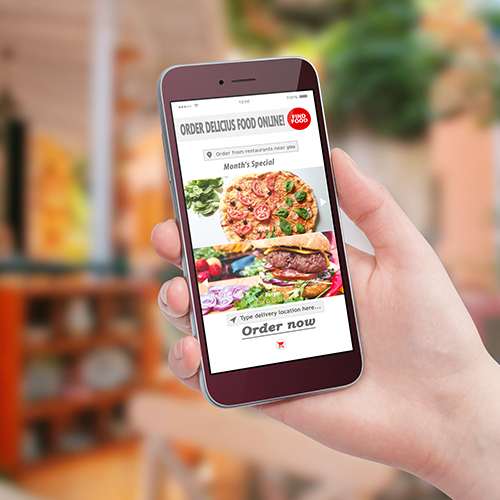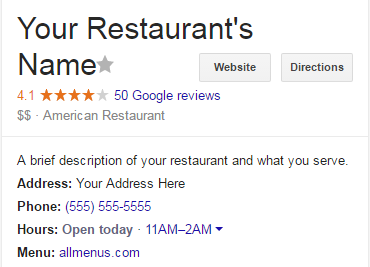How to Make Your Restaurant Stand Out on Google
Last updated on Mar 6, 2025Kayla NelsonHaving a strong online presence is just as essential to your restaurant marketing plan as word-of-mouth referrals. Studies show that over 75% of customers look at menus before choosing a restaurant. Posting your menu online and having an engaging website can help draw both new and returning customers to your restaurant. Give yourself an edge over the competition by following the tips below to boost your online ranking and improve your existing site.
What Is Restaurant SEO?
Once you’ve created your restaurant’s website, it’s good to make sure it’s optimized for search engines, like Google, Bing, and Yahoo, so they can find your content, store it in their database, and provide it to users in relevant searches. Search engine optimization (SEO) is the process of improving your website to increase its visibility in search engines and the amount of traffic your website gets. SEO differs from paid search/advertising in that it is an organic (free) way to boost your website’s ranking.
Basic SEO for restaurants should ensure your phone number, hours of operation, location, and menu show up in local searches and are up to date. While SEO can be technical, there are some basic practices you can use to help optimize your restaurant’s website and organic ranking. We've put together a list of nine restaurant SEO tips to follow:
1. Keyword Research
Keywords are the words and phrases, or search queries, a user enters into a search engine to find relative content. Before you begin keyword research, understand who is your target market and how they are searching for your business. Here are some questions to ask yourself:
- What Are People Searching For? If you operate a bakery, what kinds of bakery items are people searching for? Are they looking for gluten-free or vegan options?
- Why Are They Searching? Are people looking to fulfill large orders of baked goods or are they looking for a grab-and-go snack?
- When Are They Searching? Are there seasonality trends? Do people want baked goods during the holidays?
Knowing the answer to the questions as it relates to your target audience will help you formulate the correct keywords. When creating your website’s content, it’s important to include both niche and local keywords so that your website shows up when potential customers search for your type of restaurant.
For example, let’s say you’re trying to improve SEO for your vegan bakery located in Charlotte, NC. Here’s a list of keywords you might want to target:
- vegan bakery
- vegan desserts
- vegan donuts
- vegan bakery charlotte nc
- vegan cupcakes charlotte nc
Fortunately, there are plenty of free keyword research tools from companies like Moz, Semrush, and Ahrefs that you can use to find applicable keywords for your business and location.
2. Create Original Content

Search engines value content that is original, clear, and engaging to readers. Creating content that is made for and relevant to users, and not search engines, should always be your priority. For example, let’s say you are trying to target the keyword “pizza Tampa”. That’s not how one would normally speak, so it wouldn’t make sense to put that phrase in your About Me section just for the sake of including the keyword. Including phrases like “pizza in Tampa”, “authentic New York style pizza in Tampa”, or “best pizza in downtown Tampa” will all target the intended keyword and looks natural to readers.
Your content should also be informative to customers, easy to navigate, and representative of your business. Including content on the below topics on your site can help establish a stronger brand, which will help improve your rankings.
- Brand: Highlighting your business's history, mission, and any unique qualities, such as sourcing local and organic food or hosting live events, are all great to include for customers.
- Location and Business Hours: The location(s) of your business, phone numbers, and business hours should all be information a customer can easily find on the homepage.
- Menu: Make sure your menu is up to date with the current selections, pricing, and any specials. If you offer happy hour specials, clearly provide which days of the week, the time of day, and what food times are included in happy hour.
- Online Ordering: With an increasing amount of customers wanting take-out options for their favorite foods, having an online ordering platform is a great way to acquire new business and create repeat customers.
- Reservations: If you accept reservations in your restaurant, provide a link to request a reservation online or add a clickable call button so customers can easily make a reservation.
3. Make Your Website Mobile Friendly
With so many people accessing the internet on their smartphones, you must be sure your website and menu are mobile friendly. The best practice for this, in terms of ranking high on Google, is to display all the same content as a desktop version, but formatted and arranged specifically for a mobile device’s screen size. Additionally, you should always offer guests the option to view the desktop version of your site on their mobile device, if they wish.
Because potential customers will be viewing your menu on a smaller screen, you need to make everything easily readable and clickable. Be sure any images or graphics are high resolution. While you may get away with lower-quality images on a desktop screen, phone screens will easily show blurry or pixelated images.
Ensure your online menu is engineered to be mobile-responsive. While desktop users may appreciate a full-size view of your menu, this can become cluttered or hard to read on a smaller, mobile device. Instead, try breaking your menu up into clickable categories. For example, you could break it down into something as simple as breakfast, lunch, dinner, and dessert, or offer more specific categories such as salads, soups, poultry, seafood, and pastas. If your menu is currently displayed as a PDF on your site, it is recommended you take screenshots or re-upload them as text on the page. Additionally, you should consider a font size of at least 14 pixels and bigger button sizes so that users can easily click them.
4. Offer High-Resolution Images

Give guests a taste of your menu offerings by incorporating high-quality images on your site. While you want to limit the number of graphics or images to keep site speeds fast, a few eye-catching design elements can draw customers in before they even look at your menu. If you offer unique, Instagram-worthy dishes or cocktails, displaying high-quality photos of them on your site can even interest foodies looking to post images of fun foods on their own social media accounts.
In addition to showcasing unique menu items, uploading a few professional images of your dining area, outdoor patio, or any other special features will also help entice customers. When choosing a place to eat, many users also search for what the inside of a restaurant looks like if they like the menu to get a general feel for its atmosphere. The images you feature on your site will also populate in Google's image search, which can help boost your rankings in local search.
5. Link Your Site to Social Media Accounts
As guests are perusing your site, make it easy for them to connect to your various social media accounts. Include links to your Facebook, Instagram, or Twitter to give them a more personal feel for your establishment. If you post regular updates on your social media accounts, you may also want to consider implementing a live feed on your site showing your posts and updates.
Linking to your social media sites also encourages guests to interact with your business online before, during, and after their visit. Use this opportunity to gain feedback, obtain customers’ photos of your food, and encourage patrons to revisit regularly.
6. Create a Free Listing on Google My Business

Creating a free listing on Google My Business allows customers to keep up to date on your hours, address, reviews, wait times, and phone number. It can also be used to update and maintain your profile and current hours of operation. Plus, Google My Business drops a location pin for your restaurant on Google Maps, making it easier for guests to find your restaurant. A location pin on Google Maps can also attract patrons perusing the site for local restaurants who may not have heard of your business before.
7. Film an Indoor Google Street View of Your Restaurant

Another way to increase visibility and transparency is to add an indoor street view of your restaurant. This will appear in Google search results and on Google Maps. Creating an indoor street view gives future customers a virtual tour of your restaurant. This can help them to visualize themselves in your space and anticipate their dining experience.
Because indoor street views are conducted and posted by a third party, they can help build consumer trust even before customers visit your business. These street views are especially important because, according to Google, customers who view a business listing with a virtual tour are twice as likely to book a reservation. And, it gives your business an advantage over other local establishments that have not yet participated in this opportunity.
8. Encourage Reviews
For many, the search for a new restaurant starts online, which includes checking online reviews. Encouraging customers to leave reviews can help boost your business's credibility, click-through rates, and ranking. The more good reviews you have, the higher your website will be ranked in search results because Google can see you offer customers a positive experience.
If you have an email marketing list, try sending an email to your subscribers asking for a review. Or, simply post a “Let us know how we’ve been doing!” sign in your business to encourage your guests to share their thoughts.
9. Submit Your Menu to Third Party Sites

Uploading your menu to third-party sites such as AllMenus or MenuPages goes a long way towards bringing your business more publicity. These sites house menus from restaurants all over your area, making them a one-stop shop for hungry customers.
Because they’re already well-established domains, these sites often appear within the first page of relevant search terms on Google – including “restaurant websites” and “restaurant search sites.” By submitting your menu to these sites, you can better connect with guests who are specifically searching for your menu. Additionally, you may catch the eye of customers searching for similar restaurants in your area.
Back to TopUsing good SEO practices for your restaurant is a great way to improve your ranking on Google and draw new customers to your restaurant. As you build your restaurant's web presence, post an updated version of your menu to as many places as possible and spruce up your existing website to distinguish yourself from the competition.



